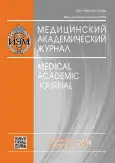THE EFFECT OF ACUTE HYPEGLYCEMIA ON THE ACTIVITY OF THE ANTIOXIDANT SYSTEM IN THE CENTRAL NERVOUS SYSTEM AND IN THE LIVER OF THE INVERTEBRATE MOLLUSK - LYMNAEA STAGNALIS
- Authors: Shadenko VN1, Sidorov AV1
-
Affiliations:
- Department of Human and Animal Physiology, Belarusian State University
- Issue: Vol 19, No 1S (2019)
- Pages: 37-39
- Section: Articles
- Published: 15.12.2019
- URL: https://journals.eco-vector.com/MAJ/article/view/19313
- ID: 19313
Cite item
Abstract
Comparison of dynamic changes of biochemical reactions in the liver and CNS of freshwater liver mollusc LYMNAEA STAGNALIS has been conducted. It has been conducted during incubation in the highly concentrated solution of glucose. The indicators of superoxiddismutase (SOD) activity, the level of renewed glutation (G-SH), Se-dependant glutation peroxidase (Se-GP) and TBA-active products were estimated and compared. Also for the tissues of the Central Neural System and tissues samples of liver it was found out by glucoseoxidate method the concentration of glucose in haemolymph of the investigated biological object in the conditions of hyperglycemia. A comparative estimation of the general protein concentration in both tissues was conducted. Resistance of the liver tissue to hyperglycemia and a reverse effect towards CNS was found out.
Keywords
Full Text
About the authors
V N Shadenko
Department of Human and Animal Physiology, Belarusian State University
A V Sidorov
Department of Human and Animal Physiology, Belarusian State University
References
- Tups A., Benzler J., Sergi D., Ladyman S. R., Williams L. M. Central regulation of glucose homeostasis. Comp. Physiol. 2017;7:741-764. https://doi.org/10.1002/cphy.c160015.
- Sidorov AV, Maslova GT. State of antioxidative protection in central nervous ganglia of the mollusc Lymnaea stagnalis at modulation of activity of the NO-ergic system. J. Evol. Biochem. Physiol. 2008;44(5):435-441. https://doi.org/10.1134/S0022093008050010.
- Sidorov AV. Nerve centers functional activity in invertebrates. Minsk: BSU; 2011. (In Russ.).
- Veldhuijzen JP. Effects of different kinds of food, starvation and restart of feeding on the haemolymph-glucose of the pond snail Lymnaea stagnalis. Neth. J. Zool. 1974;25:89-102. https://doi.org/10.1163/002829675X00146.
- Glantz S. Primer of Biostatistics. NY: McGraw-Hill, Inc.; 1994.
Supplementary files







